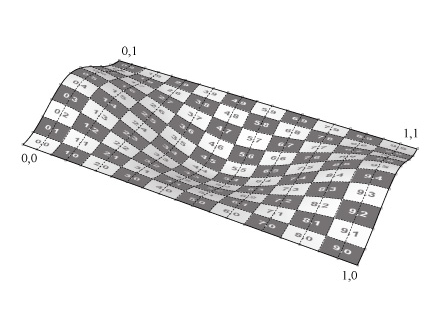| Texture Mapping | |
|---|---|
| Rendering often requires that a texture be made and oriented in a direction that is not the default direction assumed by the object when it is made in Rhino. This method covers the methods and options for applying texture maps to 3D models in Rhino for rendering. | |
| Part of | Rhinoceros |
| Part Type | Method |
| Screenshot |

|
Steps
Introduction to Texture Mapping
To open the Texture Mapping toolbar , right click the main toolbar and select "Texture Mapping." To see what textures are applied to the model, right click on the viewport name and select " Rendered ."
There are several different ways to apply textures to a 3D model in Rhino. The most basic method for applying a texture to an object is to open the Material Editor for the object's layer, clicking on the check box for Texture, and selecting the correct texture Map file.
To obtain textures, refer to the resources associated with each step. For other textures, see the Resources section, below. Textures can also be created from scratch by manipulating a photograph in Photoshop.
- Files
- basemodel.3dm
- Brick texture
Surface Mapping
The default option in Rhino for texture mapping is Surface Mapping, which stretches the texture to the extents of the surface it is applied to. To do this, apply a texture to a layer through the Material Editor. Make sure the surface that you want to apply texture to is on the layer with the correct texture.
- Files
- Persian rug texture
Box Mapping
Box Mapping applies the texture to all sides of the object based on a Mapping Widget that is shaped like a box. To create the Mapping Widget after applying a texture to the object, select the Box Mapping icon in the Texture Mapping toolbar (or use the ApplyBoxMapping command). Select the object and press enter again to select mapping channel 1. Select the corners of the box and then the height of the box according to the prompts so that they align with the object. Press enter to select a single texture space, which means that the entire texture will be mapped on each surface (divided means that distinct regions of the texture will be used for each space). Finally, enter values for Tiling in the U and V directions. Adjust the parameters as needed to ensure the texture map is exactly how you want it.
Cylindrical Mapping
To get the texture of one object to match another, open the Material Editor of the layer that currently does not have a texture. Click on the Match button at the bottom of the Editor, then select the object that has the texture you want to match.
Cylindrical Mapping applies the texture to a cylinder. Click on the Cylindrical Mapping icon (or use the ApplyCylindricalMapping command). Select the object and press enter again to select mapping channel 1. Click on where the map should start. Press enter to select a single texture space, and, finally, enter values for Tiling in the U and V directions. Adjust the parameters as needed to ensure the texture map is exactly how you want it.
Planar Mapping
Planar Mapping applies the texture to a defined plane. Click on the Planar Mapping icon (or use the ApplyPlanarMapping command). Select the object and press enter again to select mapping channel 1. Then, click on the corners of the plane, making sure that all the points are in the same plane. Press enter to select a single texture space, and, finally, enter values for Tiling in the U and V directions. Adjust the parameters as needed to ensure the texture map is exactly how you want it.
- Files
- Roofing texture
Common Problems
Resources
- CGTextures
- Vast library of high-resolution textures for download. Account registration required.
- Maya NG's Textures
- Over 4250 free, high-resolution textures. Limited to 20 downloads per day.